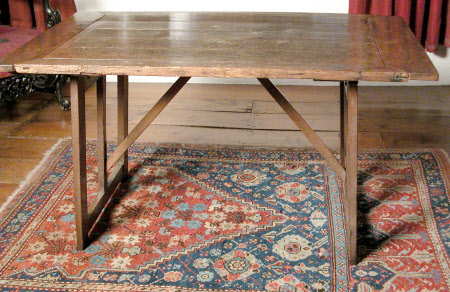Table
Category
Furniture
Date
1650 - 1750
Materials
Chestnut
Measurements
700 x 780 mm; 1310 mm (Length)
Place of origin
Cotehele
Order this imageCollection
Cotehele, Cornwall
NT 347839.7
Caption
This table was probably made on the Cotehele estate during the 17th century. It is one of seven similar tables in Cotehele House, of which only one retains its original folding mechanism. They are known as 'Spanish Tables', in the belief that the design was copied from folding tables salvaged from the wreckage of the Spanish Armada. Cotehele's tables may have been made for Colonel Piers Edgcumbe (1610-66) who took up residence here during the 1650s, and extensively remodelled the interior.
Summary
Table. One of seven similar tables with folding supports of plain design. Chestnut or oak. According to Victor Chinnery (2004): An oak folding table, the five-plank rectangular mitre framed top with angled wooden braces bearing a paper label inscribed in ink No1. English, c.1650-1750. According to Dr Adam Bowett (2002): This is entirely of oak. The form is similar to a common 17th and 18th century type known in English inventories as a ‘Spanish’ table. These usually have folding metal struts, rather than the wooden ones used here. Apart from one or two obvious repairs, the table is in very original condition. The hinges and nails are hand-made, suggesting a date prior to c.1800-1820. The oak is pit-sawn, and comes from fast-grown timber, quite different from the imported wainscot used by urban cabinet-makers and joiners. This might reinforce the supposition that the table was made by the estate carpenter, but this must remain speculative.
Provenance
According to Victor Chinnery (2004): Date of acquisition unknown, but recorded with others at Cotehele in Nicholas Condy’s views, c.1840.
